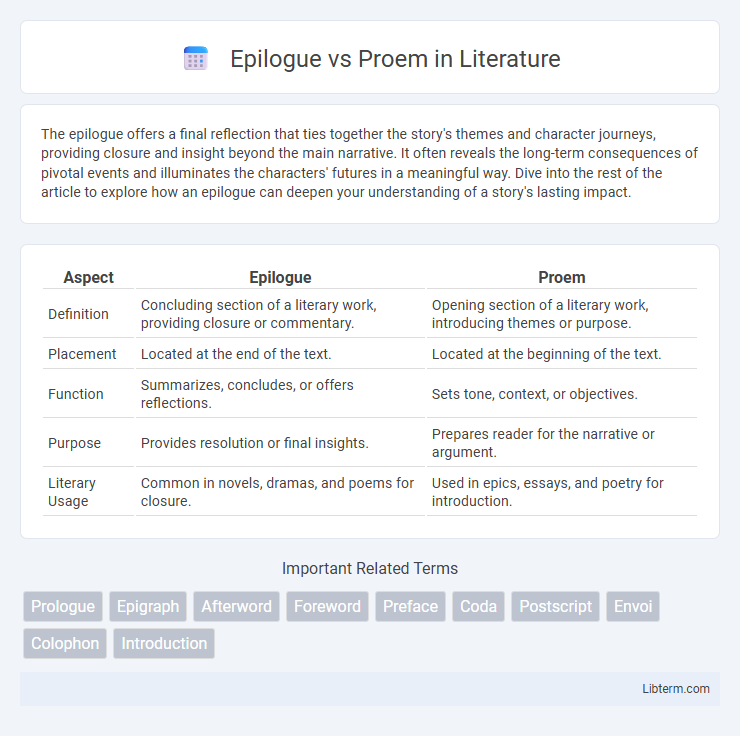The epilogue offers a final reflection that ties together the story's themes and character journeys, providing closure and insight beyond the main narrative. It often reveals the long-term consequences of pivotal events and illuminates the characters' futures in a meaningful way. Dive into the rest of the article to explore how an epilogue can deepen your understanding of a story's lasting impact.
Table of Comparison
| Aspect | Epilogue | Proem |
|---|---|---|
| Definition | Concluding section of a literary work, providing closure or commentary. | Opening section of a literary work, introducing themes or purpose. |
| Placement | Located at the end of the text. | Located at the beginning of the text. |
| Function | Summarizes, concludes, or offers reflections. | Sets tone, context, or objectives. |
| Purpose | Provides resolution or final insights. | Prepares reader for the narrative or argument. |
| Literary Usage | Common in novels, dramas, and poems for closure. | Used in epics, essays, and poetry for introduction. |
Defining Epilogue and Proem
An epilogue is a concluding section of a literary work that provides closure, reveals the fate of characters, or offers final reflections. In contrast, a proem serves as an introductory passage, setting the tone, context, or themes before the main narrative begins. Both elements are crucial for framing a story, with the proem establishing initial understanding and the epilogue delivering resolution.
Historical Origins of Epilogue and Proem
The historical origins of the epilogue trace back to ancient Greek drama, where it served as the concluding speech offering closure or moral reflection, often delivered by a character or chorus. The proem, derived from the Greek "prooimion," functioned as an introductory preface setting the thematic stage for epic poems and classical literature. Both forms evolved within classical antiquity, influencing narrative structures by framing stories with a defined opening and closing to guide audience interpretation.
Structural Placement in Literature
The epilogue is structurally placed at the end of a literary work, serving to provide closure or commentary after the main narrative concludes. In contrast, the proem, often synonymous with a prologue, appears at the beginning to introduce themes, context, or background information before the main story unfolds. This distinct placement affects how readers engage with the text, with the proem setting the stage and the epilogue offering reflection or resolution.
Primary Functions and Purposes
Epilogues primarily serve to provide closure by resolving remaining plot points and revealing the future fates of characters, ensuring narrative completeness and emotional satisfaction for the audience. Proems function to introduce themes, set the tone, and offer context or background, guiding readers into the story's world and establishing expectations. Both elements structure a narrative by marking the formal beginning or end, but epilogues reflect backward on the story's outcomes, while proems anticipate and prepare for the unfolding narrative.
Narrative Impact on the Reader
An epilogue provides closure by revealing the aftermath or future consequences of the story, deepening the reader's emotional resonance and understanding of the narrative's themes. A proem, often found in classical literature, sets the tone and establishes expectations, engaging the reader's curiosity and framing the story's context. Together, these structural elements shape the reader's interpretive experience by bookending the narrative with a reflective conclusion and an anticipatory introduction.
Common Literary Examples
Epilogues and proems serve distinct functions in literature, with epilogues often providing closure or insight after the main narrative, exemplified in Shakespeare's "Romeo and Juliet" where the Prince's speech wraps up the tragedy. Proems, or prologues, introduce the theme or set the tone, seen notably in Homer's "Iliad" which opens with an invocation to the Muse. Common literary examples highlight how epilogues reflect on consequences or future implications, while proems prepare the reader for the story's unfolding context and mood.
Differences in Tone and Style
Epilogues often adopt a reflective and conclusive tone, providing closure and summarizing the narrative's outcomes, while proems typically have an anticipatory and inviting style designed to introduce themes and engage readers from the outset. The epilogue's style tends to be contemplative and explanatory, offering insights or moral lessons, whereas the proem employs a more motivational and thematic approach, setting the mood and context for the story. This tonal and stylistic contrast enhances the narrative structure by framing the story's beginning and end with distinct emotional and literary purposes.
Usage in Modern Writing
Epilogues in modern writing serve to provide closure by revealing the future of characters or resolving lingering plot points, often appearing at the end of novels, plays, or films. Proems, less common in contemporary works, function as introductory passages that set the tone or context, frequently found in poetry or classic literature. Writers utilize epilogues to enhance reader satisfaction and clarify themes, while proems establish thematic groundwork or mood before the main narrative unfolds.
Authorial Intent and Creative Choices
Epilogues serve as authorial tools to provide closure, clarify thematic resolutions, and offer insight into characters' futures, emphasizing the completion of narrative arcs. Proems, by contrast, function as creative openings designed to set tone, establish context, and engage readers' curiosity through thematic foreshadowing or direct authorial address. The choice between epilogue and proem reflects strategic decisions in narrative structure, with epilogues reinforcing finality and proems inviting interpretive anticipation.
Choosing Between Epilogue and Proem
Choosing between an epilogue and a proem depends on narrative purpose and timing within a text; an epilogue provides closure and reflects on events after the main story, enhancing reader understanding of consequences, while a proem functions as an introduction that sets thematic expectations and tone before the narrative unfolds. Writers prioritize epilogues when emphasizing resolution and character futures, whereas proems are selected to establish context and engage readers from the outset. Strategic use of either element influences narrative structure, pacing, and thematic resonance.
Epilogue Infographic

 libterm.com
libterm.com